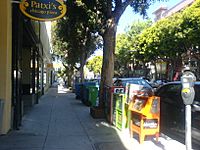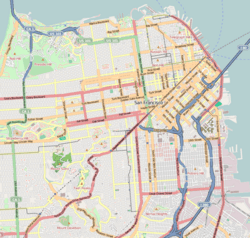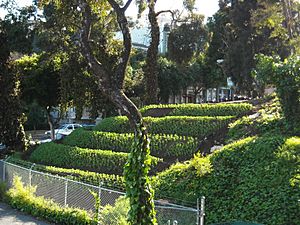Hayes Valley, San Francisco facts for kids
Quick facts for kids
Hayes Valley
|
|
|---|---|

Looking west along Hayes Street from Octavia Boulevard.
|
|
| Country | |
| State | |
| City-county | San Francisco |
| Area | |
| • Total | 0.180 sq mi (0.47 km2) |
| • Land | 0.180 sq mi (0.47 km2) |
| Population
(2008)
|
|
| • Total | 5,672 |
| • Density | 31,476/sq mi (12,153/km2) |
| Time zone | UTC-8 (Pacific) |
| • Summer (DST) | UTC-7 (PDT) |
| ZIP codes |
94102, 94117
|
| Area codes | 415/628 |
Hayes Valley is a cool neighborhood in the Western Addition district of San Francisco, California. It's located between the historic areas of Alamo Square and the Civic Center. In Hayes Valley, you'll find a mix of old Victorian houses, fancy shops, and tasty restaurants. The neighborhood is named after Hayes Street, which got its name from Thomas Hayes. He was an important person in San Francisco in the 1850s.
Contents
Where is Hayes Valley Located?
Hayes Valley is generally found around Hayes Street. It stretches between Webster Street (near Alamo Square) and Franklin Street (near the Civic Center). The main shopping and dining area is on Hayes Street itself. This part runs from Laguna Street to Franklin Street.
The Hayes Valley Neighborhood Association has a slightly wider definition. They consider the area to be between Webster Street in the west and Van Ness Avenue in the east. It goes from Fulton Street in the north to Hermann Street and Market Street in the south. This area sometimes overlaps with the Lower Haight neighborhood.
Hayes Valley is next to several other neighborhoods. These include the Lower Haight, parts of the Duboce Triangle, and SoMa to the south. Alamo Square is to the west, the Civic Center is to the east, and the Fillmore District is to the north.
How to Get Around Hayes Valley?
Hayes Valley has good public transportation. Several San Francisco Municipal Railway (MUNI) buses serve the area.
- The #21 bus runs east-west through Hayes Valley. It connects Golden Gate Park to the Ferry Building.
- The #5 bus also goes east-west.
- The #22 bus runs north-south along Fillmore Street.
- The #6 and #7 buses both travel east-west along Haight Street.
Residents can also use the Van Ness Avenue Muni subway station. This station is shared with nearby neighborhoods like Civic Center. From here, you can catch J, K, M, L, N, and T subway cars. These lines can take you to many places across San Francisco.
A Look at Hayes Valley's Past
Long ago, Ohlone people lived in the San Francisco area. They gathered food in places like Mission Creek, which included Hayes Creek. Hayes Valley would have been full of wildflowers every spring. Hayes Creek used to flow above ground, but now it runs underground all year.
In 1776, the Spanish empire took control of the area. This happened when the Juan Bautista de Anza expedition arrived. They built Mission San Francisco de Asís south of Hayes Valley.
Hayes Valley in the 1800s
After the 1849 California Gold Rush, many Italian immigrants came to the area. They started farms in Hayes Valley's sandy soil.
The Western Addition area was developed in the 1850s. This was to expand San Francisco to the west. Michael Hayes, who helped name streets in 1856, might have named Hayes Street after his brother, Thomas. Thomas was a big landowner in the area.
Many large Victorian homes were built in Hayes Valley. Smaller houses were also built for the people who worked on these mansions. Important local citizens and families had streets named after them, like Hayes and Gough. Streets with smaller houses often got botanical names, such as Lily, Ivy, and Linden.
Hayes Valley in the 1900s
The part of Hayes Valley south of McAllister Street was lucky. It was saved from the fires that followed the 1906 San Francisco earthquake. After World War II, the nearby Fillmore district grew. Hayes Valley became a diverse neighborhood, including many African-American families.
Hayes Valley Today: The 2000s
Since the year 2000, Hayes Valley has seen many changes. It has become a very popular and trendy part of San Francisco. Real estate agents now market the neighborhood to people looking for upscale homes.
The Central Freeway's Impact
An elevated highway called the Central Freeway was built in Hayes Valley in the 1950s. This was part of U.S. Route 101. However, it was damaged during the 1989 Loma Prieta earthquake. After the earthquake, local groups worked hard to have the freeway removed.
Taking down the Central Freeway helped Hayes Valley become a lively place. It now has a cool mix of unique shops, fancy restaurants, and trendy stores on Hayes Street.
In 2005, a part of the freeway was rebuilt. It now ends at Market Street. A new, tree-lined street called Octavia Boulevard runs north through Hayes Valley. Between Fell and Hayes streets, there's a special park called Patricia's Green. It has seating, green space, and a play area for kids. It also features changing art exhibits. The park is named after Patricia Walkup, a local hero. She worked hard to make the neighborhood safer and helped get the freeway removed.
In 2010, the city turned some empty lots into the Hayes Valley Farm. These lots were where the old freeway ramps used to be. The farm was a project focused on urban gardening and community use. Volunteers were allowed to use the land until the city had other plans for it. In 2012, plans were approved to build shops and homes on the site. An apartment complex is now being built there.
What is Hayes Valley's Culture Like?
In early 2013, the SFJAZZ Center opened in Hayes Valley. This is a brand new concert hall dedicated to jazz music. It's special because it was the first building in the western United States built just for jazz performances and education.
What is Cerebral Valley?
Cerebral Valley is a new nickname for a part of Hayes Valley. It refers to a concentration of groups, startups, and "hacker houses" focused on generative AI. This trend started in the early 2020s during the AI boom. Events like the Cerebral Valley AI Summit have taken place here.
The term "Cerebral Valley" became popular in January 2023. It describes how many AI-focused communities and "hacker houses" gathered in the neighborhood.
"Hacker houses" are places where groups of people live and work together on artificial intelligence projects. They became popular in the early 2020s. This was partly due to job changes in big tech companies and a return to in-person events after the COVID-19 pandemic. These houses are seen as a way to return to the roots of Silicon Valley. Many of these hacker houses are in historic Victorian homes near Alamo Square.
Some well-known hacker houses in Cerebral Valley include AGI House and Genesis House.
Who are Some Notable People from Hayes Valley?
- George W.C. Baker, who served on the Los Angeles City Council, went to Hayes Valley Grammar School.
- David Hirota, who was called the "Hayes Valley Mayor" from 1999 to 2005.
What are Some Important Buildings in Hayes Valley?
- Charles Dietle House
- Ida B. Wells Continuation High School
- International High School of San Francisco
- San Francisco Zen Center
- SFJAZZ Center



